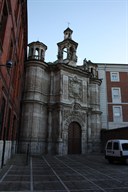Church of the Pasión, Church of San Juan de Letrán, Convent of the Agustinos Filipinos
 Traces of Baroque taste and art are identifiable even in the façades of some important religious buildings in the city. Located a few metres from the Plaza Mayor, the Church of the Cofradía Penitencial de la Sagrada Pasión de Cristo (Confraternity of the Sacred Passion of Christ), more simply known as the Church of the Pasión, was built in the late sixteenth century. The cofradía (confraternity), composed largely of artists, sculptors and painters, however, decided to enhance the appearance of the church during the seventeenth century, entrusting Felipe Berrojo de la Isla iwith the indoor decoration and ordering the construction of a new stone façade, in Baroque style, which was concluded in 1672.
Traces of Baroque taste and art are identifiable even in the façades of some important religious buildings in the city. Located a few metres from the Plaza Mayor, the Church of the Cofradía Penitencial de la Sagrada Pasión de Cristo (Confraternity of the Sacred Passion of Christ), more simply known as the Church of the Pasión, was built in the late sixteenth century. The cofradía (confraternity), composed largely of artists, sculptors and painters, however, decided to enhance the appearance of the church during the seventeenth century, entrusting Felipe Berrojo de la Isla iwith the indoor decoration and ordering the construction of a new stone façade, in Baroque style, which was concluded in 1672.
 Even the Church of San Juan de Letrán (Saint John Lateran) is famous for its Baroque façade. The construction of the church began in 1675, but lasted for decades. The main facade, facing the Parque del Campo Grande, in fact, was built around 1730, according to the draft by Matías Machuca, one of the leading exponents of Baroque in the city. The alternation of convex and concave surfaces gives great mobility to the whole, which is divided into two wings, cylindrical, and a central body. The latter is spread over two floors, the centre of which dominate the portal on the floor below, and Spain’s royal coat of arms (a tribute to the royal patronage of the church) is in the upper one. On the top, a small temple houses the statue of Saint John the Baptist, flanked by representations of the Faith and Charity in women’s clothes.
Even the Church of San Juan de Letrán (Saint John Lateran) is famous for its Baroque façade. The construction of the church began in 1675, but lasted for decades. The main facade, facing the Parque del Campo Grande, in fact, was built around 1730, according to the draft by Matías Machuca, one of the leading exponents of Baroque in the city. The alternation of convex and concave surfaces gives great mobility to the whole, which is divided into two wings, cylindrical, and a central body. The latter is spread over two floors, the centre of which dominate the portal on the floor below, and Spain’s royal coat of arms (a tribute to the royal patronage of the church) is in the upper one. On the top, a small temple houses the statue of Saint John the Baptist, flanked by representations of the Faith and Charity in women’s clothes.
 Next to the Church of San Juan de Letran one can admire the convent of the Agustinos Filipinos, built starting in 1759 according to a design by the famous architect Ventura RodríguezTizón Buenaventura Rodríguez, better known as Ventura Rodríguez (1717-1785) is regarded as the last Spanish Baroque architect, although his production already had elements typical of Neoclassicism. Among his works are the inside of the Monastery of the Encarnación (Incarnation), the exterior of the Palace of Liria and the design of the fountain of Cibeles in Madrid, the façade of the convent of the Agustinos Filipinos in Valladolid and the Santa Capilla of the Basilica of Nuestra Señora del Pilar (Our Lady of Pilar) in Zaragoza.. The structure began as a seminary which formed the Augustinian fathers to be sent as missionaries to the Philippines, according to a plan approved by Clement XII and placed under the patronage of King Philip V. The structure and appearance of the building are typical of the art of Ventura Rodríguez, midway between Baroque and Neoclassicism, although the construction of the monastery was completed well 171 years after the start of the work, in 1930. In the interior there are paintings and sculptures created between the sixteenth and the twentieth century. The building also houses the Museo oriental (Oriental Museum), the most important of its kind in Spain.
Next to the Church of San Juan de Letran one can admire the convent of the Agustinos Filipinos, built starting in 1759 according to a design by the famous architect Ventura RodríguezTizón Buenaventura Rodríguez, better known as Ventura Rodríguez (1717-1785) is regarded as the last Spanish Baroque architect, although his production already had elements typical of Neoclassicism. Among his works are the inside of the Monastery of the Encarnación (Incarnation), the exterior of the Palace of Liria and the design of the fountain of Cibeles in Madrid, the façade of the convent of the Agustinos Filipinos in Valladolid and the Santa Capilla of the Basilica of Nuestra Señora del Pilar (Our Lady of Pilar) in Zaragoza.. The structure began as a seminary which formed the Augustinian fathers to be sent as missionaries to the Philippines, according to a plan approved by Clement XII and placed under the patronage of King Philip V. The structure and appearance of the building are typical of the art of Ventura Rodríguez, midway between Baroque and Neoclassicism, although the construction of the monastery was completed well 171 years after the start of the work, in 1930. In the interior there are paintings and sculptures created between the sixteenth and the twentieth century. The building also houses the Museo oriental (Oriental Museum), the most important of its kind in Spain.
